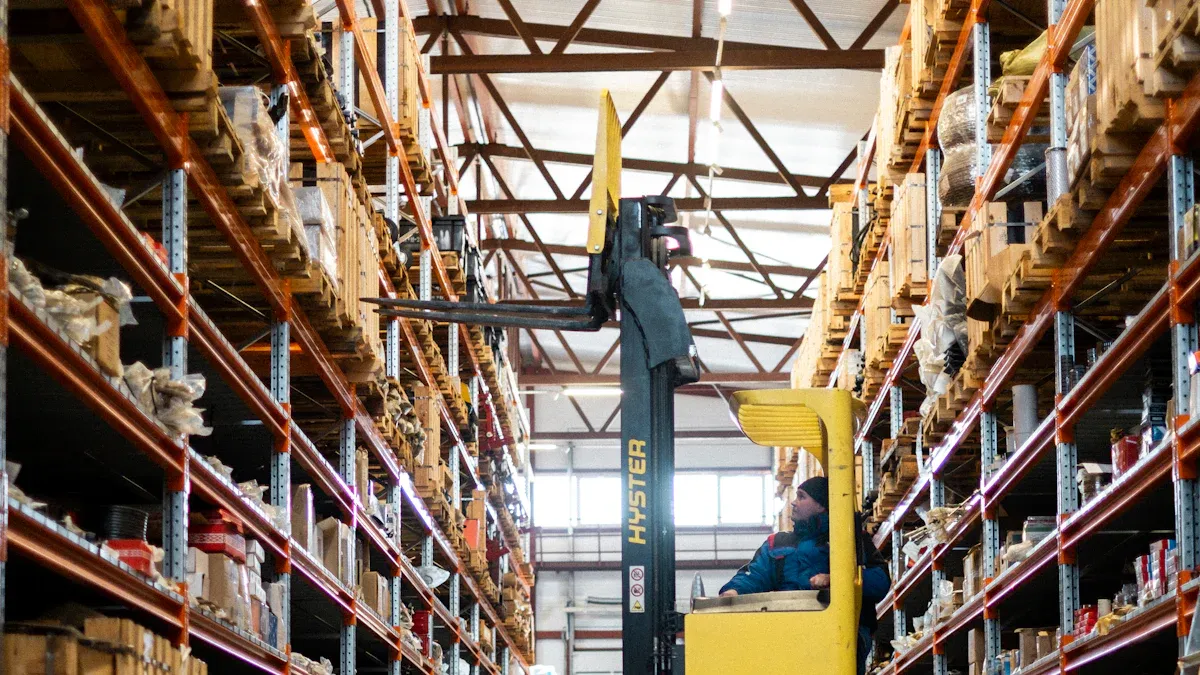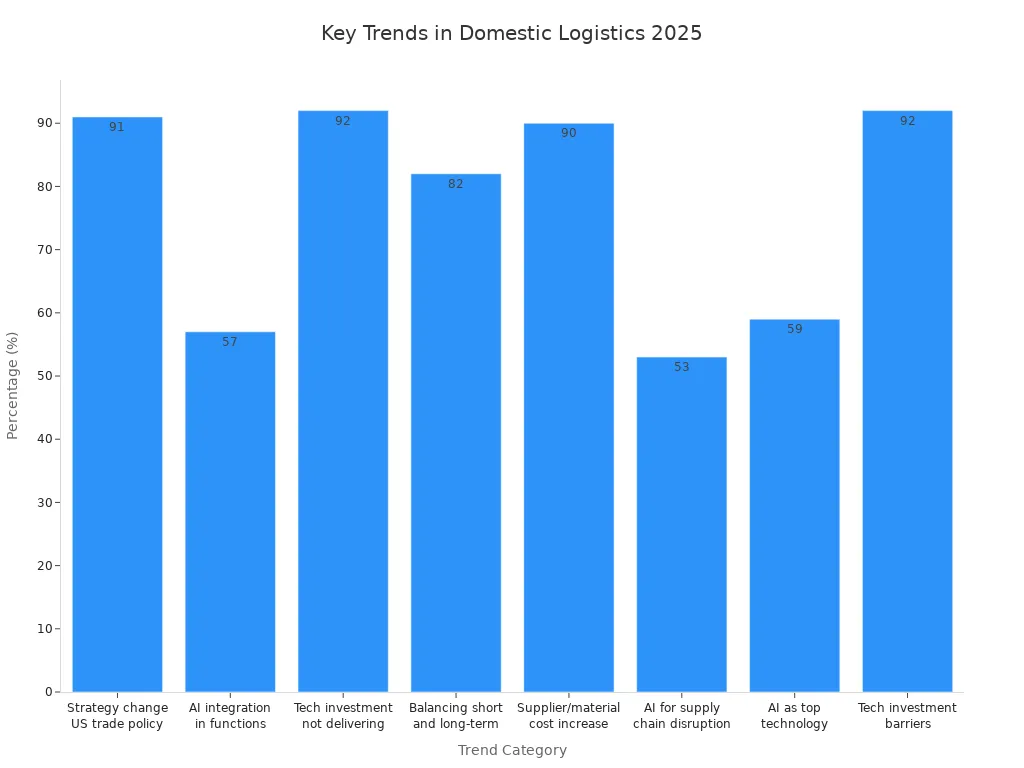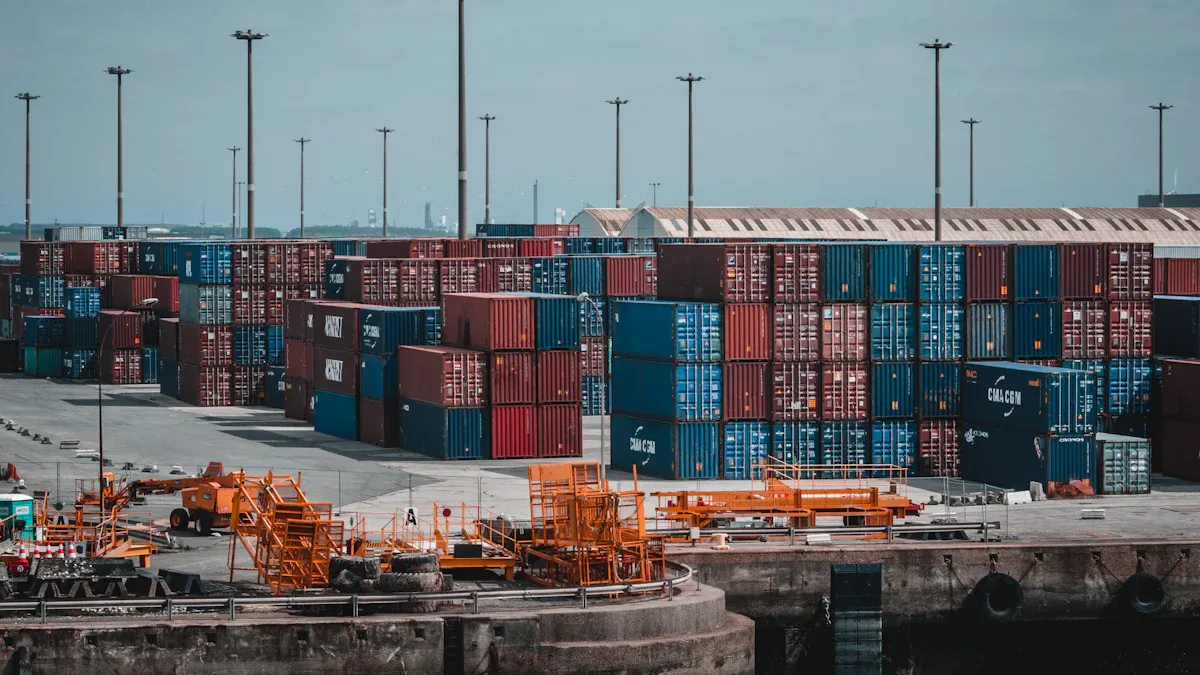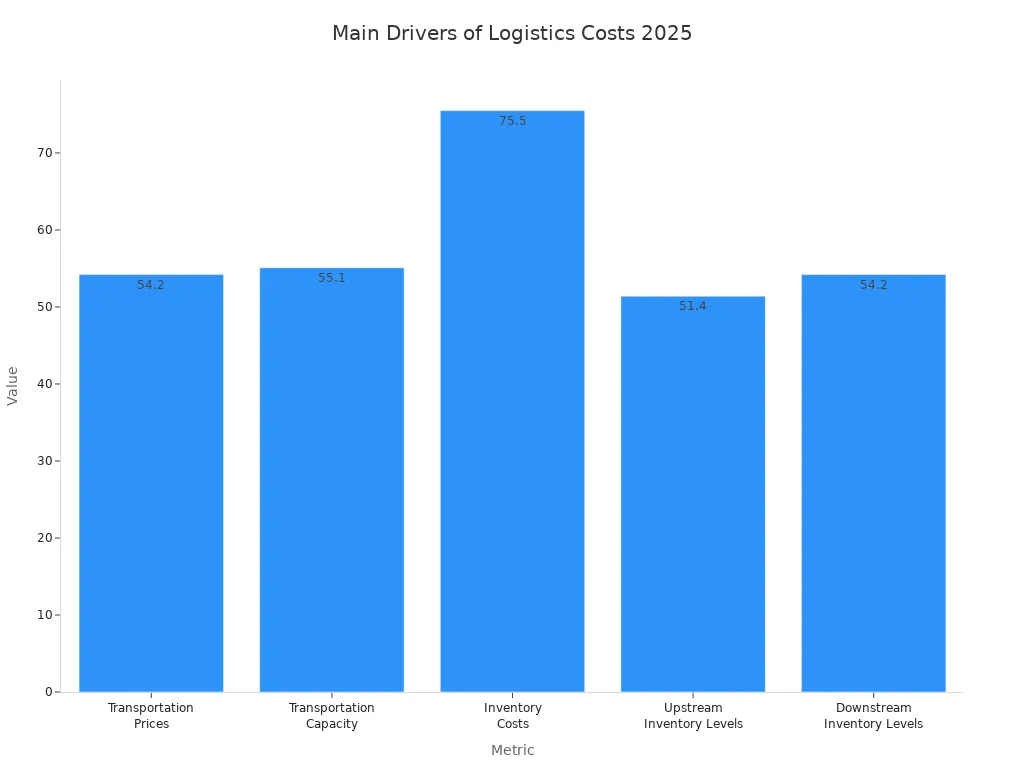A Practical Guide to Domestic Logistics Services in 2025

You see rapid changes in domestic logistics services in 2025. Automation and AI now drive daily operations. Regulations shift, forcing you to rethink your approach. The need to adapt grows urgent as workforce skills and technology investments decide your success.
Companies invest in upskilling and cybersecurity to stay ahead. Data-driven decisions help you compete and respond to market changes.

Statistic | Value | Description |
|---|---|---|
Operations and supply chain leaders changing strategies due to US trade policy changes | Significant shift in logistics strategies influenced by regulatory changes. | |
Companies integrating AI into functions | 57% | Growing trend of AI adoption in logistics. |
Leaders citing tech investments not delivering expected results | 92% | Challenges in achieving desired outcomes from technology investments. |
Leaders facing challenges in balancing short-term and long-term strategies | 82% | Complexity of managing immediate needs and future plans. |
Leaders expecting significant increases in supplier and material costs | 90% | Economic pressures impacting logistics operations. |
Companies using AI to mitigate supply chain disruptions | 53% | Role of AI in enhancing operational resilience. |
Companies using AI as a top technology | 59% | Prevalence of AI in logistics technology adoption. |
Leaders citing reasons for tech investments not meeting expectations | 92% | Integration complexity and data issues as major barriers. |
A domestic logistics services guide helps you find practical strategies to succeed in this changing environment.
Key Takeaways
Automation in warehouses reduces manual labor needs by up to 45%, improving efficiency and accuracy.
AI technology helps logistics companies make smarter decisions, predict demand, and enhance service quality.
Real-time tracking systems provide continuous updates on shipments, increasing customer trust and satisfaction.
Building strong partnerships with carriers and suppliers is essential for navigating challenges and improving logistics operations.
Staying adaptable to regulatory changes and investing in technology can help businesses thrive in the evolving logistics landscape.
Domestic Logistics Services Guide: 2025 Essentials

Automation in Warehousing
You see warehouses in 2025 that look very different from just a few years ago. Automation now plays a central role in how you move, store, and pick products. Many companies use advanced machines and robots to handle tasks that once needed large teams of workers. This shift helps you save time and reduce mistakes.
Here are some of the most impactful automation technologies you find in modern warehouses:
Technology Type | Description |
|---|---|
Autonomous Mobile Robots (AMRs) | Robots that independently navigate warehouse floors to transport goods between different areas. |
Automated Storage & Retrieval Systems | Enclosed systems that use robots and machinery to move goods between storage racks and picking stations. |
Robotic Arms | Devices that pick up, move, and place individual items with precision. |
Benefits of Robotic Automation | Greater efficiency, smarter resource allocation, scalable operations, precision, predictability, and visibility across workflows. |
When you use these systems, you notice big changes in your daily operations:
You need fewer workers for manual tasks. Companies report a 45% reduction in manual labor after installing automated systems.
Rocky Mountain ATV saw a 45% drop in labor needs and improved shipping accuracy to 99.97% with the OPEX® Sure Sort® system.
Boux Avenue cut temporary labor by 33% and sped up order fulfillment with the same technology.
A domestic logistics services guide helps you understand which automation tools fit your business best. You can compare options and see how others have improved efficiency and accuracy.
AI-Driven Operations
Artificial intelligence now shapes almost every part of your logistics process. You use AI to make smarter decisions, predict demand, and solve problems before they grow. This technology helps you save money and improve service quality.
The table below shows how AI improves different areas of domestic logistics:
Application Area | Improvement Description |
|---|---|
Warehouse Operations | AI boosts efficiency with robots and predictive stocking models. You see fewer errors and better inventory control. |
Transportation | AI finds the best routes in real time. You save on fuel and deliver faster. |
Last-Mile Delivery | Drones and self-driving vehicles bring packages to your customers quickly and flexibly. |
Environmental Impact | AI plans routes that use less fuel and cut emissions, making your business greener. |
You rely on AI to spot trends and adjust your plans. This means you can react quickly to changes in demand or supply. A domestic logistics services guide gives you tips on using AI tools and shows you how other companies have gained an edge.
Tip: Start with small AI projects, like route planning or inventory checks. You can expand as you see results.
Real-Time Tracking
You want to know where your shipments are at all times. In 2025, real-time tracking gives you this power. You use several technologies to watch your goods as they move through the supply chain.
Technology Type | Function |
|---|---|
GPS Systems | Provides location data |
IoT Devices | Monitors conditions such as temperature or humidity |
RFID Tags | Allows for quick scans at different checkpoints |
These tools help you track every step of a shipment’s journey. You get updates on location, condition, and delivery times. This level of detail builds trust with your customers and helps you fix problems fast.
The benefits of real-time tracking include:
Benefit | Description |
|---|---|
Continuous Monitoring | You receive ongoing updates on shipments, which improves visibility and accuracy. |
Accurate Delivery Information | You can give customers precise ETAs and proactive notifications, which reduces their anxiety. |
Elimination of Blind Spots | You see the whole journey, so you can spot delays and reroute shipments if needed. |
Proactive Communication | You inform customers about delays, which keeps their trust even when things go wrong. |
Increased Customer Trust | Customers feel confident when they can track packages and get timely updates. |
Improved Operational Efficiency | Better visibility means fewer mistakes and lower costs, which helps you build loyalty. |
A domestic logistics services guide explains how to set up these tracking systems and use the data to improve your service. You learn how to keep your customers happy and your operations running smoothly.
Key Trends in Domestic Logistics
Predictive Analytics and Risk Management
You now use predictive analytics to make smarter decisions in logistics. These tools help you plan routes, avoid delays, and keep your vehicles running smoothly. With AI, you move from reacting to problems to stopping them before they start. You can see how this shift improves your daily work:
You optimize delivery routes for speed and cost.
You plan for disruptions, like weather or traffic.
You schedule maintenance before breakdowns happen.
Here is how predictive analytics changes your results:
Measurable Outcome | Description |
|---|---|
Improved Efficiency | You forecast disruptions and choose the best routes. |
Reduced Waste | You cut empty miles and save fuel. |
Enhanced Decision-Making Capabilities | You predict demand and adjust resources quickly. |
Increased On-Time Delivery Rates | You deliver more packages on time and use less fuel. |
Lower Maintenance Costs | You fix vehicles before they break, saving money. |
Improved Customer Satisfaction | You give customers better delivery windows and updates. |
Sustainability Initiatives
You see more companies working to protect the environment. Many focus on simple changes, like reducing idling times and planning better routes. About 43% of companies save fuel by cutting idle time, and 40% use route optimization to lower emissions. Fewer companies invest in electric fleets, but those who do see big savings.

Switching to electric vehicles lowers costs by 17% per vehicle over five years. You also help the city by reducing trips, cutting air pollution by 35%, and easing traffic during busy hours.
Shift to Regional Carriers
You notice more businesses choosing regional carriers. E-commerce growth and rising costs from national carriers push this change. Regional carriers offer faster, cheaper shipping and better tracking. Here are the main reasons for this shift:
Factor | Explanation |
|---|---|
E-commerce growth | You need faster, affordable shipping for more online orders. |
Cost-efficiency | Regional carriers help you avoid high surcharges. |
Advancing technology | Better software lets you track shipments with regional carriers. |
Capacity constraints | Regional carriers fill gaps when big carriers get too busy. |
You adapt by using a mix of national and regional carriers. You split inventory across hubs closer to your customers. This strategy helps you avoid delays and keeps your shipping flexible.
Changing Consumer Demands
Your customers want more than just fast delivery. They expect to see where their package is at every step. Real-time tracking and data analytics give them this visibility. You also face new challenges from global events and a bigger focus on sustainability.
Change in Consumer Demand | Description |
|---|---|
Customers want real-time updates and clear tracking. | |
Geopolitical Shifts | Trade changes affect how you plan and move goods. |
Rise of Sustainability and Technology | Customers prefer companies that use green practices and new tech. |
A domestic logistics services guide helps you keep up with these trends. You learn how to use new tools, build strong partnerships, and focus on customer service.
Challenges Facing Logistics in 2025

Labor Shortages
You face a tight labor market in 2025. Many companies struggle to find enough skilled workers for warehouses and transportation. This shortage slows down operations and increases costs. You can address these challenges by:
Reducing turnover with better pay and flexible schedules.
Upskilling your team with digital training and cross-training programs.
Offering clear career paths to keep employees motivated.
Building talent pipelines by working with local groups.
Technology helps you bridge the gap. Automation, AI, and digital tools boost productivity and reduce your need for manual labor.
Rising Costs and Capacity Issues
Costs keep rising across logistics. Transportation prices jumped by 21.7%, and warehouse rents increased by 9.5%. You also see capacity tightening as carriers face weak profits and lower production rates.

Metric | Value | Change from Previous Month | What It Means |
|---|---|---|---|
Transportation Prices | 54.2 | -1.9 | Slowest growth since April 2024 |
Transportation Capacity | 55.1 | -2.2 | Less space for shipments |
Inventory Costs | 75.5 | -3.7 | Costs are rising fast |
You can fight these pressures by using fuel-efficient vehicles, exploring alternative fuels, and expanding your carrier network. Technology like predictive routing also helps you use resources better.
Regulatory Shifts
You must keep up with new rules in 2025. Changes include speed limiter rollbacks, autonomous truck trials, and shifts in emissions policies. These updates affect how you plan routes and manage compliance.
Regulatory Change | Impact on Logistics |
|---|---|
Faster, more efficient trucking | |
Autonomous truck trials | Lower labor costs, higher safety |
Emissions policy reversals | New environmental requirements |
You can adapt by reviewing your supply chain, using technology for compliance, and seeking cost-effective solutions.
USPS Changes Impact
USPS now controls more of the parcel shipping process. You see the end of ounce-based pricing for light parcels and fewer discounts for consolidators. These changes may raise shipping costs and slow down deliveries.
You may need to pass higher costs to customers.
Transit times could increase.
Hybrid carriers might partner with regional carriers for better service.
Stay flexible by diversifying your carrier options and keeping customers informed about changes.
Strategies for Success in Domestic Logistics
Building Partnerships
You build strong partnerships to improve your logistics results. Trusted relationships with carriers, suppliers, and technology providers help you solve problems quickly. You share information and resources to keep your supply chain moving. When you work together, you can handle disruptions and meet customer needs faster. Many companies choose to diversify their partners to avoid delays and shortages. You also join local networks to find new talent and share best practices.
Technology Adoption
You gain a competitive edge by using the latest logistics technologies. AI leads the way in 2025, helping you make smarter decisions and improve efficiency. You use SaaS software to connect your supply chain and track shipments in real time. Visibility and connectivity let you spot issues before they grow. Here are ways technology drives your success:
AI boosts your planning and delivery speed.
SaaS platforms help you manage orders and inventory.
New tools give you better visibility and control.
You use transportation as a way to stand out from competitors.
A domestic logistics services guide helps you choose the right technology for your business.
Enhancing Customer Service
You focus on customer service to keep clients happy and loyal. You give real-time updates and proactive notifications so customers know where their packages are. You make returns and refunds easy, which builds trust. Personalizing the shipping experience helps you connect with each customer. You scale your operations to handle more orders without losing quality. You improve picking and packing to deliver on time. Careful route selection ensures fast and accurate deliveries.
You train your team to use technology and data. You also use predictive freight visibility to solve problems before they affect customers.
Compliance and Adaptability
You stay ahead by following new rules and adapting quickly. You track your carbon footprint and use energy-efficient vehicles to meet environmental standards. You report on ESG performance and use digital tools for compliance. You manage risks with advanced logistics technology. Companies face more disruptions and complex operations, so you need flexible solutions. You use AI for predictive analytics and blockchain for transparency. Autonomous vehicles and drones help you deliver faster and stay compliant.
Compliance Measure | Description |
|---|---|
ESG Reporting Rules | You show proof of your environmental and social practices. |
Technology for Compliance | You use digital tools to track and improve your supply chain. |
Risk Management | You use advanced technology to handle disruptions and keep operations smooth. |
A domestic logistics services guide gives you steps to stay compliant and adapt to new challenges.
You see big changes in domestic logistics in 2025. Automation, AI, and new rules shape your daily work. To succeed, you should:
Invest in smart technology and training.
Build strong partnerships with carriers and suppliers.
Stay flexible and ready for new rules.
Keep learning and testing new ideas. You can lead the way by adapting quickly and using innovation to solve problems.
FAQ
What is the biggest change in domestic logistics for 2025?
You see automation and AI leading the way. Robots and smart software handle tasks faster and with fewer mistakes. You save time and money.
Tip: Start with small automation projects to see quick results.
How do you choose the right carrier for your business?
You compare speed, cost, and tracking options. Regional carriers often offer better rates and faster delivery for local shipments.
Check reviews
Test service quality
Ask about tracking features
What steps help you stay compliant with new regulations?
You use digital tools to track shipments and report on environmental impact. You review rules often and train your team.
Note: Staying updated helps you avoid fines and delays.
How does real-time tracking improve customer satisfaction?
You give customers updates at every step. They see where their package is and feel confident.
:package: Customers trust you more when you share delivery status.
See Also
Enhancing Global Operations Through Innovative Logistics Strategies
Key Strategies for Effective Global Logistics Management
Optimizing East Coast Imports With Premier Global Logistics Solutions
Streamlined Inventory Management Using Premier Global Logistics Services
Understanding B2B Warehousing and Distribution by Premier Global Logistics
